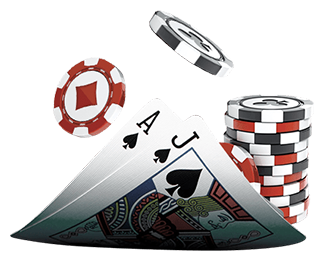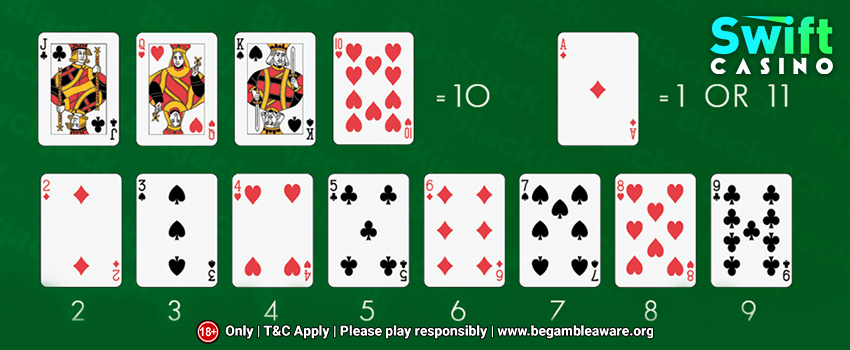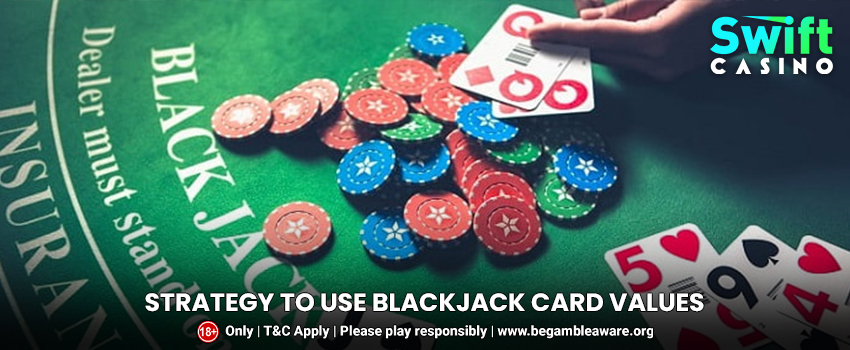One of the reasons behind blackjack’s popularity is its simplicity and ease of gameplay. Many blackjack terms and regulations are easy to comprehend and follow, making this game one of fan favourites. The goal of the gameplay is to come as near to 21 as possible without crossing over it whilst exceeding the dealer’s total. You place a wager before receiving your 2 beginning cards, then request one additional card at a point or “stand” if you don’t wish to proceed. Every blackjack session has 5 potential scenarios:
| Your hand situation | Result |
| ≤ 21 + Higher total than dealer | Win |
| ≤ 21 + dealer goes bust | Win |
| Your total = Dealer’s total. A push and your stake is returned | Push |
| ≤ 21 + dealer beats your total without going bust | Lose |
| You Bust | Lose |
What you need to know about blackjack’s card values?
Finding out your hand total at any given time, however, is not difficult. You don’t have to be concerned with the suit of the cards you are dealt; it doesn’t matter if they are a combination or both the identical suit. We are more focused on the numeric worth of the cards.
Cards 2 through 10 have the very same worth as their respective numbers. The game then shifts since all image or face cards (such as kings, queens, and jacks) have a value of ten. That brings us to the ace, which may be worth 1 or 11, rendering it a useful card to have because it provides you choices.
If you were to make a blackjack card value chart, it would look something like what is depicted below:
| Card | Worth | Card | Worth |
| King | 10 | 7 | 7 |
| Queen | 10 | 6 | 6 |
| Jack | 10 | 5 | 5 |
| Ace | 11 or 1 | 4 | 4 |
| 10 | 10 | 3 | 3 |
| 9 | 9 | 2 | 2 |
| 8 | 8 | 1 | 1 |
How is blackjack played and conducted?

When playing blackjack, a normal 52-card deck is used. Based on the number of participants at the blackjack table or the online casino‘s desire, the gameplay is conducted with up to 8 decks. This spares the dealer much time since he doesn’t have to pause and reshuffle a single deck of cards in between sessions.
Blackjack differs from other card games in that the player competes against the house, not with other players. That’s the first difference that you will notice when you start learning the rules and playing the game.
To begin, the dealer deals every player and themselves 2 cards. There are no hidden cards, as all of them have been turned face up save for one, which belongs to the dealer. Then each player must decide whether to “hit” or “stand,” depending on the strength of their hand. Aiming at 21 without going “bust” is the final objective. The player who comes closest to 21 wins — for example, a 9 and a 8 would triumph over a King and a 6.
How to use the card’s value in your blackjack basic strategy?

With your first five cards, you will see the dealer’s upcard, along with your own 2 cards. You can use the value of your upcard to assist you make a decision on how to proceed further with your hand.
If you have been paying attention, you would have probably noticed that there are a surprising number of cards with the worth 10 in the decks of cards you are dealing with. The odds of the following card being a 10 are therefore always in your favour. It is possible to second-guess the outcome of your hand by taking a card, all while keeping an eye on what you think the dealer’s score will be, depending on his upcard.
Let’s have a look at an example. You have been dealt a 3 and a 5, for a total of 8. Since you can’t go above 21 and bust, you will immediately take an additional card. But first, take a look at the dealer’s upcard. His 2nd card will almost certainly be a 10, making his final total 14 if he holds a poor card like a 4. He would have to take a further card after that, which would almost certainly result in his busting.
You can choose to double down before collecting your second card if you have 8 and aren’t going to bust. This doubles your initial stake. Now you’re putting double your initial stake on the blackjack table in a situation where you hope to end with a good hand and the dealer going bust probability is strong.
This fundamental blackjack technique may be applied in a variety of situations. Let’s pretend the dealer has a bad 5 upcard once more. You have been dealt an 8 and a 4, for a total of 12. You might take another card in the hopes of getting a 9 or below. But why take the chance when the dealer is vulnerable and appears to be about to go bust? Rather than that, you must pause for a moment and determine whether your concerns are correct.
Try your hand at blackjack card values and basic strategy
Don’t be alarmed if all of that seems a bit convoluted. You may get a blackjack guidance chart online that will clearly outline your best move in every situation, regardless of your 2 beginning cards or the dealer’s upcard. Then you can proceed to learning more complicated strategies, using blackjack side bets properly and what moves to employ at what time. Good luck with your blackjack journey!

